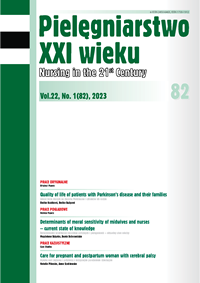Komfort czy dyskomfort u pacjentów w paliatywnej opiece domowej? – badanie pilotażowe
DOI:
https://doi.org/10.2478/pielxxiw-2023-0009Słowa kluczowe:
komfort, opieka paliatywna, pacjent, opieka domowaAbstrakt
KOMFORT CZY DYSKOMFORT U PACJENTÓW W PALIATYWNEJ OPIECE DOMOWEJ? – BADANIE PILOTAŻOWE
Wstęp. Zapewnienie komfortu u pacjentów w paliatywnej opiece domowej jest trudnym zadaniem. Opiekę, w której komfort pacjenta stanowi fundamentalne znaczenie, wprowadziła Katharine Kolcaba.
Cel pracy. Ocena poziomu komfortu u pacjentów w paliatywnej opiece domowej z uwzględnieniem wybranych uwarunkowań tego stanu.
Materiał i metody. Badaniem objęto 55 pacjentów leczonych paliatywnie w środowisku domowym, korzystających ze świadczeń realizowanych przez zespół domowej opieki paliatywnej oraz grupę 63 opiekunów nieformalnych sprawujących opiekę domową. Badania pilotażowe, metodą sondażu diagnostycznego, z wykorzystaniem kwestionariusza ankiety techniką PAPI przeprowadzono wśród pacjentów w opiece paliatywnej leczonych w środowisku domowym w pierwszym półroczu 2022 roku.
Wyniki. Wykazano istotną statystycznie zależność miedzy zadowoleniem z opieki, a poziomem zapewnianego komfortu (p<0.05). Osoby, które zdecydowanie wskazywały na zadowolenie cechowały się istotnie wyższym poziomem zapewnianego komfortu (M=35,43; SD=5,32 vs. M=33,38; SD=4.63) w porównaniu z pozostałymi pacjentami.
Wnioski. Istnieje związek pomiędzy poziomem komfortu postrzeganym przez pacjentów, a metodami zapewnienia komfortu pacjentom w warunkach domowych stosowanymi przez opiekunów nieformalnych. Osoby, które cechują się wyższym odczuciem zapewniania komfortu jednocześnie uzyskują wyższy stopień zapewnienia komfortu przez opiekuna.
Bibliografia
1. World Health Organization, WHO. Palliative care for older people: better practices. http://www.euro.who.int/__data/assets/pdf_file/0017/143153/e95052.pdf. Accessed: 20 October 2022
2. Coelho A, Parola V, Escobar-Bravo M, et al. Comfort experience in palliative care: a phenomenological study. BMC Palliative Care. 2016; 15: 71.
3. Souza MCS, Jaramillo RG, Borges MS. Comfort of patients in palliative care: an integrative review. Enfermería Global. 2021; 61: 449-463.
4. Le Grand SB, Walsh D. Comfort measures: practical care of the dying cancer patient. The American Journal of Hospice & Palliative Care. 2010; 27(7): 488-493.
5. Oliveira I. Comfort measures: a concept analysis. Research and theory for nursing practice. 2013; 27(2): 95-114.
6. Kamal AH, Gradison M, Maguire JM, et al. Quality measures for palliative care in patients with cancer: a systematic review. Journal of Oncology Practice. 2014; 10(4):281-287. doi: 10.1200/JOP.2013.001212.
7. Kolcaba KA. Theory of holistic comfort for nursing. Journal of Advanced Nursing. 1994; 19(6): 1178-1184.
8. E, Seers K. Comfort on a ward for older people. Journal of Advanced Nursing. 2004; 46(4): 380-389.
9. Lobchuk M, Degner L. Symptom experiences: perceptual accuracy between advanced-stage cancer patients and family caregivers in the home care setting. Journal of Clinical Oncology. 2002; 20(16): 3495-3507.
10. Jones J, McPherson C, Zimmermann C, et al. Assessing agreement between terminally ill cancer patients’ reports of their quality of life and family caregiver and palliative care physician proxy ratings. Journal of Pain and Symptom Management. 2011; 42(3): 354-365.
11. Nuraini T, Gayatri D, Rachmawati I. Comfort Assessment of Cancer Patient in Palliative Care: A Nursing Perspective. International Journal of Caring Sciences. 2017; 10(1): 209. https://internationaljournalofcaringsciences.org/docs/24_tuti_original_10_1.pdf
12. Kolcaba K, Di Marco M. Comfort theory and its application to pediatric nursing. Pediatric Nursing. 2005; 31(3): 187-194.
13. Kolcaba K. Zmniejszony komfort. Podręcznik diagnoz pielęgniarskich. Przewodnik planowania opieki opartej na dowodach naukowych. Ackley B, Ladwig G, (red.); Zarzycka D, Ślusarska B. (red. polska). Warszawa: Wyd. GC Media House; 2011, s. 254-256.
14. Kamal A, Gradison M, Maguire J, et al. Quality Measures for Palliative Care in Patients With Cancer: A Systematic Review. Journal of Oncology Practice. 2014; 10(4): 281-287.
15. Czernecki K, Ślusarska B. Pain problem in patients in palliative home care. Journal of Education, Health and Sport. 2022; 12(11): 63-74. eISSN 2391-8306.
16. Kuźmicz I, Brzostek T, Górkiewicz M. Zmiany sprawności ruchowej pacjentów z zaburzeniami funkcji poznawczych objętych długoterminową opieką stacjonarną w Polsce. Problemy Pielęgniarstwa. 2014; 22(2): 154-158.
17. World Medical Association. World Medical Association Declaration of Helsinki Ethical Principles for Medical Research Involving Human Subjects. Journal of the American Medical Association (JAMA). 2013; 310(20): 2191-2194.
18. Jack B, Hillier V, Williams A, et al. Hospital based palliative care teams improve the symptoms of cancer patients. Palliative Medicine. 2003; 17(6): 498-502. .
19. Jack B, Hillier V, Williams A, et al. Improving cancer patients’ pain: The impact of the hospital specialist palliative care team. European Journal of Cancer Care. 2006; 15(5): 476-480.
20. Wilby ML. Cancer patients’ descriptions of comforting and discomforting nursing actions. Int. J. Hum. Caring. 2005; 9(4): 59-63. DOI: 10.20467/1091-5710.9.4.59.
21. Quill T, Norton S, Shah M, et al. What is most important for you to achieve?: an analysis of patient responses when receiving palliative care consultation. Journal of Palliative Medicine. 2006; 9(2): 382-388.
22. Kolcaba K. Comfort theory and practice: A vision for holistic health care and research. New York: Springer Publishing Company; 2003, p. 9-17, 34-35, 59-68.
23. Kolcaba KA. Taxonomic structure for the concept comfort. J. Nurs. Sch. 1991; 23(4): 237-240. https://doi.org/10.1111/j.1547-5069.1991.tb00678.x.
24. Wensley C, Botti M, McKillop A, et al. A framework of comfort for practice: An integrative review identifying the multiple influences on patients’ experience of comfort in healthcare settings. International Journal for Quality in Health Care. 2017; 29(2): 151-162. https://doi.org/10.1093/intqhc/mzw158.
25. Blinderman C, Billings J. Comfort Care for Patients Dying in the Hospital. The New England Journal of Medicine. 2015; 373: 2549-2561. doi:10.1056/NEJMra1411746.
Pobrania
Opublikowane
Numer
Dział
Licencja
Prawa autorskie (c) 2023 Autorzy

Utwór dostępny jest na licencji Creative Commons Uznanie autorstwa 4.0 Międzynarodowe.




